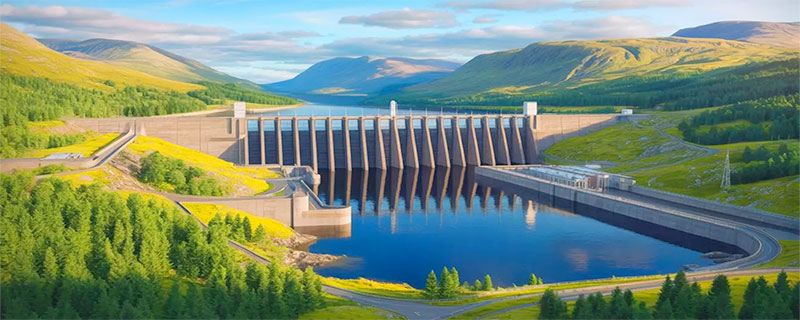UK Unleashes Energy Monster
llustration of the UK’s largest pumped-storage hydroelectric power station in the Scottish Highlands. Image generated by AI.
This Giant Powerhouse Will Fuel 1.4 Million Homes Nonstop for 22 Hours Straight
In a bold move towards energy independence, the United Kingdom has announced plans to construct its largest pumped-storage hydroelectric power station in the Scottish Highlands, capable of powering 1.4 million homes for nearly a whole day.
The United Kingdom is embarking on a groundbreaking journey to bolster its energy independence with a revolutionary new project. In a bold move, the nation is set to construct its largest pumped-storage hydroelectric power station in the picturesque Scottish Highlands. This colossal 1.8 GW facility at Loch Earba aims to store excess renewable energy and provide electricity to as many as 1.4 million homes for nearly an entire day. Such an ambitious initiative marks a significant milestone in the UK’s efforts to decarbonize its electricity grid and transition to a more sustainable energy future.
The Mechanism Behind Pumped-Storage Hydroelectricity
Pumped-storage hydroelectricity operates on a straightforward yet ingenious principle. When electricity is abundant, water is pumped from a lower reservoir to a higher one. When demand peaks, the stored water is released back down through turbines, generating electricity. This method is not only efficient but also perfectly suited to complement intermittent renewable energy sources like wind power. By storing surplus energy, these systems ensure that it can be used later when needed, enhancing the reliability of renewable energy.
In the UK, where nuclear energy has faced restrictions, and fossil fuels are being phased out, pumped-storage projects represent a critical component of the energy mix. The new facility at Loch Earba will serve as a cornerstone of this strategy, promising to harness the natural energy of water to deliver clean power without emissions. This approach underscores the UK’s commitment to reducing its carbon footprint and enhancing energy security.
Harnessing Water Force for Extended Energy Autonomy
The upper reservoir of the project, Loch Leamhain, is designed to hold enough water to generate 1.8 GW for up to 22 hours. This capacity is akin to the output of two nuclear power stations operating at full tilt, but without the associated nuclear fuel or greenhouse gas emissions. This natural accumulator will capitalize on the UK’s abundant wind resources, storing excess energy generated during high winds or at night when demand is low.
By enabling the storage and later distribution of wind energy, this infrastructure aims to prevent the waste of renewable resources and reduce the reliance on fossil fuels during peak hours. The project represents a strategic step forward, leveraging the country’s natural resources to deliver sustainable energy solutions.
A Monumental Construction Project with Ambitious Timelines
The development of this massive hydroelectric project is spearheaded by Gilkes Energy with governmental support from Scotland. The construction will involve creating dams across two lochs, building an intricate network of underground tunnels, and setting up a comprehensive technical building for production. The project is expected to take six to seven years to complete, generating approximately 500 jobs in engineering, civil works, logistics, and project management.
Such ambitious timelines reflect the urgency and importance of expanding renewable energy infrastructure. As the UK strives to achieve its zero-emission target by 2050, projects like Loch Earba play a pivotal role in ensuring a sustainable and reliable energy supply.
The Role of Long Duration Energy Storage
Classified as Long Duration Energy Storage (LDES), the Loch Earba project is critical in stabilizing the energy grid. LDES technologies are essential for minimizing power outages, reducing dependency on gas as a supplementary energy source, and addressing the growing challenge of wind energy overproduction. In the UK, every unused kilowatt-hour of wind energy translates to financial losses for producers and higher costs for consumers.
Pumped-storage hydroelectricity provides a practical solution by smoothing energy production and reducing the need for expensive and polluting thermal power plants. This strategic investment in energy storage aims to harness the full potential of renewable sources, ensuring they contribute effectively to the grid around the clock.
A Strategic Revival of Pumped-Storage Projects
It’s been over 50 years since the UK last initiated a pumped-storage project. The current energy landscape, however, has shifted significantly, with an increased focus on offshore wind farms and a steady closure of fossil fuel plants. Without adequate storage solutions, the energy system risks becoming unstable.
Gilkes Energy, in collaboration with SSE Renewables, has already proposed a second project of similar scale, illustrating the renewed interest in this technology as part of the UK’s energy strategy. Nonetheless, financing remains a hurdle, with these capital-intensive projects requiring a secure investment framework. The proposed “Cap & Floor” mechanism aims to attract private investors while mitigating risk exposure for the state.
The evolution of the UK’s energy landscape hinges on the successful integration of clean, reliable energy systems like the Loch Earba project. These large-scale pumped-storage facilities promise long-lasting durability, with operational lifespans exceeding 60 years and efficiency rates above 75%. While they do not replace wind and solar installations, they enhance their utility, supporting the UK’s ambitious emissions reduction goals. As the nation progresses toward a 2050 carbon-neutral target, will projects like these become the backbone of a sustainable energy future?
By Gabriel Cruz
Source: Sustainability times






Leave a Reply
Want to join the discussion?Feel free to contribute!